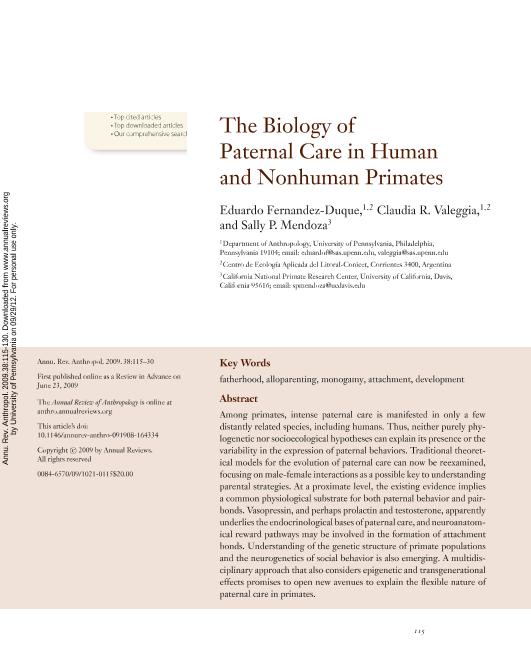Artículo
The Biology of Paternal Care in Human and Nonhuman Primates
Fecha de publicación:
10/2009
Editorial:
Annual Reviews
Revista:
Annual Review Of Anthropology
ISSN:
0084-6570
e-ISSN:
1545-4290
Idioma:
Inglés
Tipo de recurso:
Artículo publicado
Clasificación temática:
Resumen
Among primates, intense paternal care is manifested in only a few distantly related species, including humans. Thus, neither purely phylogenetic nor socioecological hypotheses can explain its presence or the variability in the expression of paternal behaviors. Traditional theoretical models for the evolution of paternal care can now be reexamined, focusing on male-female interactions as a possible key to understanding parental strategies. At a proximate level, the existing evidence implies a common physiological substrate for both paternal behavior and pair-bonds. Vasopressin, and perhaps prolactin and testosterone, apparently underlies the endocrinological bases of paternal care, and neuroanatomical reward pathways may be involved in the formation of attachment bonds. Understanding of the genetic structure of primate populations and the neurogenetics of social behavior is also emerging. A multidisciplinary approach that also considers epigenetic and transgenerational effects promises to open new avenues to explain the flexible nature of paternal care in primates.
Palabras clave:
Fatherhood
,
Alloparenting
,
Monogamy
,
Attachment
,
Development
Archivos asociados
Licencia
Identificadores
Colecciones
Articulos(CECOAL)
Articulos de CENTRO DE ECOLOGIA APLICADA DEL LITORAL (I)
Articulos de CENTRO DE ECOLOGIA APLICADA DEL LITORAL (I)
Citación
Fernandez Duque, Eduardo; Valeggia, Claudia Rita; Mendoza, Sally P.; The Biology of Paternal Care in Human and Nonhuman Primates; Annual Reviews; Annual Review Of Anthropology; 38; 1; 10-2009; 115-130
Compartir
Altmétricas




